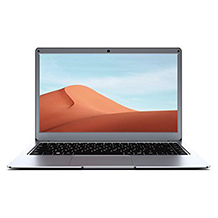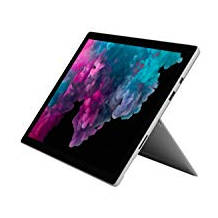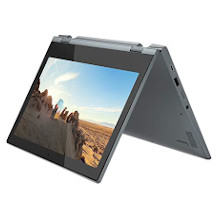15-inch laptop purchasing advice: how to choose the right product
- What You Need to Know
- The screen diagonal of 15-inch notebooks is almost always 15.6 inches, or 39.62 centimetres.
- Laptops of this size are suitable for home use, but are also easy to transport.
- The more powerful the hardware, the bulkier the device and the higher the price.
- The screen of your notebook should be at least Full HD capable.
- If you use demanding programmes, the battery life will fall well below the number of hours specified by the manufacturer.
The all-rounder among laptops
The inch specification of a notebook or laptop refers to the screen diagonal. 15 inches corresponds to 38.1 centimetres. However, 15-inch notebooks are hardly available these days. When we talk about 15 inches, we actually mean 15.6 inches, i.e. 39.62 centimetres. Such laptops are medium-sized and represent the preliminary stage to the large 17-inch notebooks. Accordingly, they are not only used on the road, but also at home.
On the one hand, 15-inch notebooks can neither match the performance of a powerful desktop nor the compactness of a 13-inch notebook or tablet. On the other hand, they can unite the two worlds as an intermediate solution. User groups such as students who are on the move a lot and often move or travel often use 15-inch notebooks because they are large enough to watch a movie or open several windows at the same time, but compact enough to be taken to the university or library.

For this reason, they are often called multimedia laptops. Because the case is larger than is the case with netbooks, for example, somewhat more powerful hardware fits inside, such as a hard drive, a good graphics card or a ventilation system with large fans. Connections for USB, HDMI and even an optical drive are usually present as well, unlike the thinner and lighter ultrabooks.
Pro points
- Screen is also suitable for watching movies and multitasking
- Mobile use
- Powerful models available
Drawbacks
- Weaker than a good desktop
- Less portable than a smaller notebook
To each his own notebook
When deciding what to buy, it is important to be clear about what the 15-inch notebook will be used for. After all, the computer’s field of application has a considerable influence on the relevant components and the appropriate price range. In addition, most laptops cannot be upgraded. Accordingly, the specifications will probably not change as long as you use the laptop. If you already have a PC that meets your needs and you just need a device for travelling, you don’t have to spend much. If the 15-inch laptop is your only computer, on the other hand, you should go for a high-quality device. After all, your needs may change over time, even if they are limited at the moment.
Users who only use office programmes and an internet browser do not need a high-quality, powerful device. For as little as about 300 euros, they can find a laptop that is suitable for writing and surfing.
Those who use their laptops for demanding programmes, such as sound, image or even video editing programmes, or who plan to play games on the device, need an expensive model. Such activities require a good processor and RAM, an up-to-date graphics card and a lot of memory. To meet these requirements, at least 1,000 euros are usually due.

Hardware: the performance drivers
The hardware installed in the computer is decisive for the performance of the device. As a rule, the higher the quality of the individual components, the higher the price. The size or thickness of the case also plays an important role here. After all, the individual components have to fit inside the laptop. Models that are mainly designed for Microsoft Office work and surfing are therefore usually thinner, lighter and more portable, while gaming laptops are thicker and bulkier. Which hardware is essential for your laptop depends on your needs.
Processor
The processor – also known as CPU (Central Processing Unit) – is rightly called the heart of the computer. After all, it is the central processing unit of the computer. All commands and programmes are processed by it. The more demanding the programmes or games are, the more powerful the processor must be to deliver the desired performance. A high number of cores goes hand in hand with high performance and speed. The rule here is: a lot helps a lot. The same applies to the frequency of the cores in gigahertz (GHz). The number of cores is usually included in the model name and can range from 2 to 16. Most laptops are equipped with a processor from one of the two market leaders Intel or AMD.
Working memory
The RAM (Random Access Memory) is essential for the operation of the notebook. It stores data from running programmes for a short time. When the laptop is shut down, the RAM is emptied. The more data a programme processes, the greater the need for a large amount of RAM. If you do more with the laptop than just writing and surfing – that is also possible with four gigabytes – a RAM of at least eight gigabytes is recommended.
Graphics card
The graphics card is responsible for the laptop’s graphics output. For example, it plays films or games and ensures that they run smoothly. Graphics cards in laptops are often integrated into the processor. This saves manufacturers space and money. Good graphics cards cost several hundred euros and do not even fit into thin laptops. If you gamble or edit videos on your laptop, you should look for a 15-inch notebook with a current high-quality graphics card. You can usually find such a model in the higher price segment. You should also expect a somewhat thicker and heavier device here. NVIDIA and AMD have the edge in the graphics card segment.

Memory
Every computer needs memory to store data. Extensive programmes, songs, films, pictures or computer games require a particularly large amount of memory. Word and Excel files, on the other hand, take up hardly any. The necessary capacity therefore depends on your needs. There are two types of storage available: the HDD hard disk and the SSD storage.
HDD (Hard Disk Drive) hard drives take up a lot of space because they consist of several components that work mechanically. For this reason, they are also somewhat more susceptible to damage. On the other hand, they offer enormous storage capacity for a low price. Compared to SSDs, however, they are much slower.
SSDs are much more compact and are therefore used more often in laptops. The absence of mechanical components not only makes them smaller, but also more robust. There is hardly any wear and tear. They are also much faster than hard disks. However, they do not come close to the price-performance ratio of HDDs. If you want an SSD with a lot of storage space, you have to be prepared to spend a lot of money. If you want to store large files on another device or an external hard drive, an SSD is the way to go: It provides fast access to files, is reliable and compact.
If you store everything directly on your 15-inch laptop and want to access your files quickly, you should go for a laptop with HDD-SSD hybrid storage. This way you combine the high capacity of an HDD with the retrieval speed of an SSD. In this case, you can store the operating system on the SSD, for example, so that the computer starts up quickly. Music and films that you do not necessarily need to access quickly can be stored on the HDD.
Cooling system
To regulate its temperature and prevent overheating, the notebook needs a cooling system. Unlike PCs, which can also be equipped with water cooling, only air cooling is possible for laptops. The reason for this is the lack of space in the case. Air coolers use fans that drive the heat that builds up inside the laptop to the outside. With fans comes a certain noise level. The smaller they are, the higher the speed and the louder the operation.
Connections
The range of connections varies greatly from model to model. Some models only have a connection for the charging cable and headphones. Since 15-inch notebooks are also considered multimedia laptops, they are usually equipped with more connections.

Two to three USB ports are basically always to be expected. An HDMI port should also be included in case you want to connect the laptop to a larger screen for a movie night, for example. For a reliable internet connection, you should also make sure that an Ethernet input is available. If you do not have your games, films and music in digital form, but prefer CDs and DVDs, you will need an optical drive. A wireless WLAN and Bluetooth connection is possible with almost all devices.
Hardware requirements at a glance
In the following table you will find examples of appropriate hardware requirements for different areas of use or needs. The listed specifications do not refer to a specific model, but are orientation values that you can expect in a rough price range.
| Specifications | Office programs and Internet | Multimedia laptop | High-end gaming laptop |
| Processor | Intel Core i3 | Intel Core i5 | Intel Core i7 |
| Memory | 4 GB | 8 to 16 GB | At least 16 GB |
| Graphics card | Intel HD Graphics (integrated in processor) | NVIDIA GeForce GTX 1650 | NVIDIA GeForce RTX 3070 Laptop GPU |
| Storage | 256 GB SSD | 512 GB SSD | 1 TB HDD to 256 GB SSD |
| Connections | Charging cable, headphones | Charging cable, headphones, 2 x USB 3.0, HDMI, Ethernet | Charging cable, headphones, 3 x USB 3.1, HDMI, Ethernet, optical drive |
| Price | Up to 500 € | Up to 1,000 € | Over 1,000 € |
Other purchase criteria
In addition to hardware specifications, attention should also be paid to other components. Some of these are also to be understood as hardware, as is the case with the battery or screen. However, they have no direct influence on the performance of the device, but rather on other aspects such as user comfort.
Battery life
The battery life claimed by the manufacturer can be deceptive. This is because it is measured when the computer is switched on but no programmes are running. Many 15-inch laptops have a battery life of about ten hours. During normal operation, let alone complex activities such as gaming, you can expect much less battery life.
Let the laptop be the laptop!
Many notebook users who use their device mainly at home or in the office keep it plugged in all the time. But a laptop is not a PC. Apart from wasting electricity, you also reduce the life of your battery by doing so, as it is constantly working. At best, unplug the cable when the laptop is fully charged and plug it back in when it has reached about 30 per cent.
Screen
With a laptop, the screen is an integral part of the device. Although it is possible to connect the laptop to an external screen with an HDMI connection, ideally the 15.6-inch screen is sufficient. If you only write on the computer, you don’t have to worry much about this. If you value a good picture, however, the screen of your 15-inch notebook should have a resolution of at least 1,920 x 1,080 pixels. This resolution is also called Full HD. Nowadays, high-quality gaming PCs are even 4K-capable (3,840 x 2,160 pixels).
Another important aspect is the refresh rate. However, it is rarely specified for laptops. This specification in hertz describes how many images the screen displays per second. The higher the refresh rate, the smoother the picture. Your notebook should be able to reach 60 hertz, i.e. 60 frames per second. This allows you to enjoy films without any problems. Gamers often have somewhat higher requirements. Some very expensive gaming notebooks reach a refresh rate of 144 hertz.
Multimedia: Loudspeaker, webcam, microphone
Every current notebook has a built-in camera, microphone and loudspeakers. These are sufficient for lectures or video calls. However, the quality of built-in loudspeakers and cameras is limited, even on high-quality laptops. If you want to enjoy music in good quality, you have to connect the laptop to external speakers. The microphone is not suitable for high-quality sound recording. Users who want to film themselves with a high-resolution image, as is the case with streamers, for example, will have to upgrade with an external camera.

Weight
The weight of your 15-inch notebook is mainly relevant for transport. Since they are devices with certain dimensions, they usually have a similar weight, between 1.5 and 2.0 kilograms. High-quality gaming laptops with a hard disk, a graphics card and a large fan weigh more than reduced models.
Extras
As a rule, laptops only come with an accompanying charging cable. Extras are rarely included in the scope of delivery. However, certain software may be pre-installed. If you use a 15-inch notebook as a work computer, you should go for a model with Windows 10 Pro. Among other things, Windows Professional allows users to connect the device to other computers via remote desktop. Although you can buy extras such as a bag or sleeve for your laptop, these are hardly ever included in the scope of delivery.












 954 reviews
954 reviews





